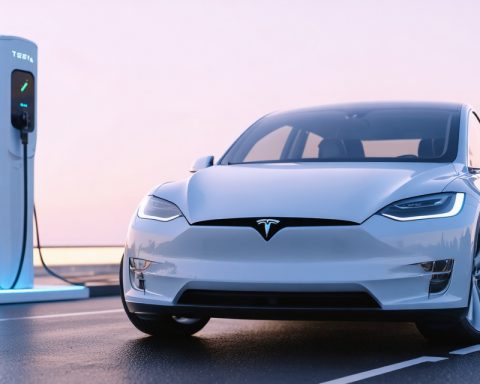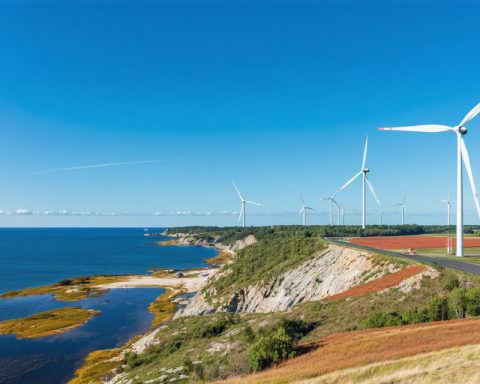- Tata Group, led by Chairman Natarajan Chandrasekaran, plans a ₹25,000 crore investment in Assam, aiming to transform India’s manufacturing sector.
- A new semiconductor assembly and testing unit in Jagiroad is set to position Assam as a global tech hub, driving India’s ambitions for self-reliance in electronics.
- This initiative promises to create 30,000 jobs, marking a significant economic boost for eastern India.
- Tata’s vision includes a green revolution through partnerships, targeting solar installations on 300,000 homes and generating 5 GW of renewable energy.
- Already employing 55,000 people and supporting healthcare with 17 cancer care hospitals, Tata’s endeavors highlight a commitment to Assam’s growth and sustainability.
- The project underscores a transformative era in tech and sustainability, elevating Assam’s status as a leader in innovation.
Amidst the lush landscapes of Assam, a technological revolution brews, poised to reshape India’s manufacturing landscape. Natarajan Chandrasekaran, the visionary chairman of Tata Group, unveiled an ambitious blueprint that promises to infuse ₹25,000 crore into the heart of Assam, propelling the state into the global electronics spotlight. Nestled in Jagiroad, a pioneering semiconductor assembly and testing unit anchors this transformation—an iconic stride as India embraces its homegrown tech future.
Chandrasekaran envisions a world where chips powering every conceivable gadget trace their roots back to this unit, a testament to the government’s foresight in nurturing the semiconductor industry. This venture marks not just a regional milestone, but an epicenter of economic propulsion for eastern India. As digital threads weave through Assam’s fabric, the group’s broader commitment involves creating an additional electronics manufacturing facility, promising 30,000 new jobs and signaling a significant employment surge.
But Tata’s vision stretches beyond silicon and circuits. In partnership with the state government, the group lays the groundwork for a green revolution. Imagine solar-paneled rooftops gleaming across 300,000 homes, while a mighty 5 GW of renewable energy pulses through the region, sculpting a cleaner, sustainable future over the ensuing years.
With roots already deep in Assam, employing 55,000 individuals and operating 17 cancer care hospitals, Tata’s investment is more than business—it’s a pledge to the people and prosperity of Assam. From tech to renewables, Tata Group’s initiative heralds a transformative era, beckoning the world to witness Assam’s remarkable ascent as a beacon of innovation and sustainability.
Assam stands on the brink of a technological renaissance, with Tata leading the charge towards a brighter, greener tomorrow.
Revolution in Assam: How the Tata Group is Transforming India’s Manufacturing Landscape
How-To Steps & Life Hacks
Setting Up a Manufacturing Unit in Assam:
1. Understand Local Regulations: Before establishing a unit, familiarize yourself with Assam’s industrial policies and subsidies available for technology and renewable energy sectors.
2. Seek Government Collaboration: Partner with local government bodies to secure approvals and support, much like Tata’s collaboration for large-scale renewable projects.
3. Focus on Sustainability: Incorporate green technologies, such as solar energy, to align with Tata’s vision for a cleaner energy future.
4. Plan Workforce Development: Develop training programs to build a skilled local workforce, addressing Tata’s strategy to create 30,000 additional jobs.
Real-World Use Cases
– Electronics Manufacturing: Utilize Assam’s new semiconductor testing unit to power tech innovations in India.
– Renewable Energy Implementation: Tap into Tata’s 5 GW renewable energy initiative, potentially reducing reliance on traditional coal-based power sources.
Market Forecasts & Industry Trends
– Growth of Semiconductors in India: The global semiconductor market is expected to grow at a CAGR of 8%, with India poised to capture a significant share due to new investments in infrastructure.
– Renewable Energy Expansion: India’s renewable energy sector is projected to reach 175 GW by 2022, with Assam contributing significantly through projects like those initiated by Tata.
Reviews & Comparisons
– Tata vs. Global Tech Giants: Tata’s venture in Assam positions it alongside global leaders in semiconductor manufacturing, emphasizing India’s potential to rival China and Taiwan.
Controversies & Limitations
– Infrastructure Challenges: Developing the necessary infrastructure in Assam might face hurdles, including logistics and supply chain complexities.
– Environmental Concerns: While aiming for green energy, projects must address any ecological impact, ensuring they align with sustainable practices.
Features, Specs & Pricing
– Semiconductor Facilities: Details on the semiconductor assembly and testing capabilities in Jagiroad remain under wraps, but industry insiders predict state-of-the-art technology akin to global standards.
Security & Sustainability
– Resilient Supply Chains: Tata’s initiative will likely bolster local supply chains, reducing dependency on imports from politically volatile regions, enhancing national security.
– Sustainability: The focus on renewable energy will substantially reduce carbon emissions, contributing to India’s climate goals.
Insights & Predictions
– Job Creation: The initiative’s success could become a model for other Indian states, promoting regional economic growth beyond metropolitan areas.
– Technological Advancement: This move could spark more investments, making India a hub for semiconductor innovation, reducing reliance on Western and East Asian tech.
Tutorials & Compatibility
– Renewable Installations: Tutorials on solar panel installations in residential areas could empower households to contribute to the renewable energy grid, similar to the Tata Group’s initiatives.
Pros & Cons Overview
Pros:
– Economic upliftment with job creation.
– Technological advancements in local manufacturing.
– Promotion of sustainable energy use.
Cons:
– Potential logistical challenges.
– Need for skilled workforce development.
Actionable Recommendations
– Engage with Local Communities: Encourage public awareness campaigns to foster community support and understanding of tech advancements.
– Focus on Continuous Learning: Invest in local education and training to ensure supply meets workforce demands, aligned with Tata’s employment goals.
– Explore Renewable Solutions: Businesses and residents should explore government incentives that may arise from such large-scale renewable initiatives, reducing energy costs and promoting sustainability.
For more information on tech and sustainability developments, visit the Tata Group website.









